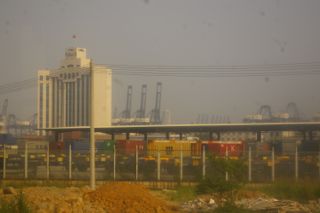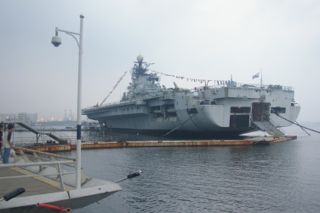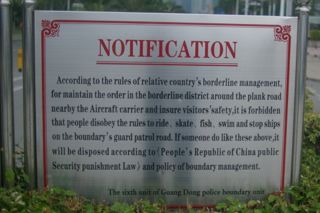We are developing the social individualist meta-context for the future. From the very serious to the extremely frivolous... lets see what is on the mind of the Samizdata people.
Samizdata, derived from Samizdat /n. - a system of clandestine publication of banned literature in the USSR [Russ.,= self-publishing house]
|
It is said, probably apocryphally, that in rejecting an appeal for the great French chemist Antoine Lavoisier to be spared the guillotine, the revolutionary judge said, “The Republic has no need of scientists”.
The great Pakistani physicist Abdus Salam, the first Muslim to win a Nobel prize for science, has been written out of Pakistani history for being the wrong sort of Muslim, writes Rob Crilly in the Telegraph. Among the saddest aspects of this story is that when reading this I could not wholeheartedly join in with Mr Crilly’s wish that Professor Salam’s name should again be honoured in his homeland. While public and elite opinion in Pakistan remains such that it does not wish to claim a great nuclear physicist – and one of the architects of Pakistan’s nuclear weapons programme – as its own, better for the world that Pakistan gets its wish.
In April, a Chinese government minister proudly announced that there are now 152m people using 3G mobile phone services in China.
An ongoing story in the Apple world is that the world’s largest mobile phone company, China Mobile (which has about 650 million customers and 70% of the mainland Chinese market), does not offer the iPhone to its customers. There has been much speculation as to when Apple and China Mobile will “do a deal” in order to offer the iPhone to its customers, many stories written by financial analysts (many working for large equities houses) expressing their puzzlement about the lack of such a deal and pressuring the two companies to get on with it. There has been much discussion as to what the business reasons for the lack of such a deal might be – possibly the two companies are at odds about shares of revenues when they sell Apps and music and movies to iPhones over their networks. Such arguments have long characterised arguments between handset vendors and mobile networks elsewhere in the world, although generally Apple has won the argument outside China.
This seems puzzling, however. There is a great deal of money to be made, right now, and this money is simply not being made by anyone at the moment. It requires parties to be very stupid indeed to concede that two parties will have 100% of nothing, rather than undecided shares of many billions of dollars, which is apparently happening here. Neither Apple nor China Mobile are stupid.
This isn’t it. There is more going on here. Or possibly less.
Last week, another piece of information came out of China. The real number of 3G users in China was in fact only half this – between 75 million and 80 million. China Mobile had “mistakenly” provided the whole number of devices sold using its TD-SCDMA technology rather than the number using 3G data services. As well as using this technology for 3G data services, China Mobile also uses it for cordless (but fixed) telephone services. The vast bulk of devices sold had been very simple essentially fixed telephones that could just be used for simple voice and text services.
So how many 3G customers does China Mobile have? Well, there are two other mobile networks in China. China Unicom operates a 3G network using W-CDMA (people who refer to “UMTS” or “HS(D)PA” are generally also talking about this technology, although the terms actually mean slightly different things), the technology used exclusively in Europe, by AT&T and T-Mobile in the US, by NTT in Japan, and by the majority of carriers elsewhere in the world. China Telecom operates a 3G network using the CDMA2000 (often referred to simply as “CDMA” in the US), used by Verizon and Sprint in the US, KDDI in Japan, and by many carriers elsewhere in the world, although far fewer than the number that use W-CDMA. China Unicom apparently had 51 million 3G customers in April. China Telecom claimed 45.56 million.
China Telecom’s number is easier to exaggerate than is China Unicom’s number, as the CDMA2000 technology was developed as a gradual evolution of the (2G) CDMAOne technology, and where you draw the line between “2G” and “3G” is somewhat arbitrary for this technology. W-CDMA was an all new air interface compared to its 2G predecessor, so (if you are being at least reasonably honest, which is never guaranteed in China) it is harder to fudge the numbers than it is for CDMA2000. Assuming that the 51 million number for China Unicom is relatively sound, and bearing in mind that China Telecom has around half the overall market share of China Unicom, a fair estimate might be that China Telecom really has around 25 million 3G customers, assuming that “3G” means people achieving similar data speeds to what is being achieved on China Unicom’s network. (China Telecom clearly do have a significant number of 3G customers. 3G devices bearing their brand were readily available and being sold aggressively in the electronics markets of Beijing when I visited last November, as were those of China Unicom. China Mobile, much less so). So that would mean that the two smaller carriers, China Unicom and China Telecom, have around 75 million 3G customers in all. Which would suggest that China Mobile, the largest mobile phone operator in the world, has, as a first order estimate, none.
This might help explain why they are unable to offer the iPhone.
So, it appears that the largest Mobile carrier in the world, in a country perceived as being rapidly advancing technologically, may have no 3G customers. Why is this?
To answer this question, we need to go back around 20 years. → Continue reading: How the Chinese screwed up their 3G mobile phone networks
Incoming from my friend Tim Evans:
Today is the sixty-first anniversary of one of the most extraordinary actions by a British army unit during the Cold War. Please, just spare 9 minutes of your time to quietly watch and reflect on a battle that has long fascinated me: the Battle of the Imjin River.
I’ve been out and about most of the day, but tomorrow morning, I will do what Tim suggests.

Mumbai, India. February 2012
What if my problem is “I cannot find anywhere to park”?
Your teeth belong to the collective.
– From a Planet Money piece quoted by Alex Tabarrok (who was linked to today by David Thompson), about how China went from the bad old days of the Great Leap Forward to the better days that followed. The above words, which Thompson also singled out for attention in his link, were an answer to a property rights query to those in authority, in the bad old days. Do we even own our teeth? No you do not.
The switch from collective “property” to actual property, as Tabarrok makes clear, was initiated by the people of China, rather than by their rulers. It began in the village of Xiaogang, whose farmers decided to go back to actual property for each individual farmer and his family, with immediate beneficial effects. And then it became a movement. The rulers of China didn’t decide to make this change. They merely decided not to stamp it out.
From a Cricinfo piece by George Dobell, about the one day cricket international between Afghanistan and Pakistan, played in the United Arab Emirates yesterday:
A spokesman for the Taliban contacted the Afghanistan Cricket Board on the morning of the game to wish the team well and assure them they would be remembered in their prayers.
Pakistan won at a canter, but the Afghans did not disgrace themselves, in their first ODI against a top ranked, Full Member, test playing nation.
Afghan minister of finance Dr Omar Zakhilwal:
“The event appears to have united the entire country. … There is nothing that can touch cricket in popularity or as a force for good in Afghanistan. There is absolutely nothing else that mobilises our society in the same way. Not politics, political events or reconstruction.”
Cricket, says Dobell, is booming in Afghanistan:
Not only is the international team now full time, but there are league teams in 28 of the 34 provinces …
However, Dobell goes on to report that:
… the sport will be made compulsory as part of the school curriculum.
And you get the definite feeling that Dobell thinks that’s good. I am a rabid cricket fan, but I say that nothing puts many people off a sport more completely than being made to play it against their will. For sport, read: anything.
I remember school contemporaries who would have preferred being in the Taliban to playing bloody cricket.
This article over at the Foreign Policy website, by Helen Mees, dusts off an argument that I have mentioned here on Samizdata before, (in relation to a comment by the US investor and commentator Peter Schiff) namely, that China, by using its vast foreign exchange reserves to buy Western government debt, thereby pushed down long-term interest rates and encouraged the kind of reckless lending that ended up going ker-boom! in 2007-2008. And if only the Chinese had not flogged us all those artificially cheap computer parts and children’s toys (made cheap by that naughty fixed exchange rate regime for the yuan), they would not have made so much money to then lend to us Westerners to blow on housing we cannot really afford. (Here is another old post of mine on the same subject of debt/savings imbalances between the West and China.)
The problem with this line of reasoning is that if, say, a country has earned genuine income by selling something valuable and useful (like toys, cars, electronic components or whatnot), and invested the proceeds abroad in things that can generate new wealth in the future, what is the problem? The problem is not that China invested huge savings and other surpluses into the West – after all, in the 19th Century, the UK invested large capital surpluses in places such as the US, Canada and Argentina (now there’s an irony, Ed). And there was nothing “imbalanced” about that. If real savings – not central bank funny money created out of thin air – gets lent to people to invest, that’s hardly bad. The problem is if the money is lent to people buying homes as part of a broader speculative bubble in real estate, say. And there is no doubt that domestic policy in the West, most definitely in the US, encouraged unwise lending and borrowing for property, consumer goods and so on, rather than investment in new technologies and industries.
The comment thread on the FP item are interesting, where it is contested that subprime borrowing made up only a tiny fraction of the US mortgage market. It did not, since one of the issues with the sub-prime market and the huge losses sustained by banks was how sub-prime debt was mixed up with better quality stuff and then sold to investors as if it is was all investment-grade, when it was wasn’t. For example, here is a comment from a person called “RRAFAY”:
“Actually, 5% of Subprime is enough to cause a crash. Especially, when no mention is made of how these mortgages were leveraged. Secondly, Alt-A is not mentioned either. When both are taken together, they represent roughly 15% of the US mortgage market. Secondly, the idea that Chinese surplus capital led to an excess supply of money is so weak, that it is mind boggling that someone would even suggest this. China only holds 7% of total US debt. Each country mentioned had a housing crisis, Ireland, Spain, and the US.”
In my view, it is certainly true that in a world of free capital movements, if a country A can export a vast amount of its capital into country B, and people in the latter country are not constrained by proper market disciplines and there is already a full-blown encouragement of high borrowing and lax lending, then the added money will pour fuel on the fire. But in the main, I think it is a pretty silly line of argument to say that it is the fault of the Chinese for having earned so much money and then reinvested it. There’s something just not quite right about that argument on so many levels.
Taylor Dinerman has written a piece for the Hudson Institute on what may be coming in North Korea. I am of two minds. So long as the existing leadership keep up the facade for the rest of the world, the level of palace intrigue can become Roman in its proportions with little effect on the countryside. The key for the North Korean Aristocracy is to do one of the things it does best: keep the majority of the population outside of the Imperial City in as deep of a dark as possible.
Should their infighting erupt in a way that allows rumours to spread into the countryside, however, the entire edifice is going to come crashing down in a matter of weeks if not days.
A few minutes back I was glancing through Chinese trade statistics, in an attempt to put together the hopefully reasonably detailed post on what is going on in China that Brian has been nagging me to write.
With respect to Europe, the stat that pops out is that Germany runs a significant trade surplus with China, but that the eurozone as a whole and even more the EU as a whole runs a large deficit. Trade patterns with China are responsible for part of the immense stresses that now exist on the €uro. The German surplus puts upward pressure on the currency at the same time that the southern deficits put strong downwards pressure on it.
One thing that comes up is the “Hong Kong Problem” in the statistics. Many containers of Chinese exports from the factories of Shenzhen and Dongguan are carried over the border into Hong Kong, and are then shipped from the port of Hong Kong. Others are carried to the port of Shenzhen and then exported from China directly. Which port is chosen determines whether the export shows up in China’s trade surplus with America or whether it shows up in Hong Kong’s trade surplus with America. It is not difficult to simply consolidate the numbers, but this is not always done, and figures are sometimes misleading because of this. The two ports of Hong Kong and Shenzhen are only a few miles away from each other, and are at present third and fourth in the list of busiest container ports in the world, but would be the busiest by far if counted together. I had seen the port of Hong Kong many times prior to my last visit to the area in 2008, but I was curious about the port of Shenzhen, so I visited the Yantian district of Shenzhen.
After I wandered down the roads between warehouses and goods yards full of containers for a time, and took many photographs through gates, a man in a uniform gestured to me to stop and went of to consult with someone else in a more impressive uniform. At this point I thought it would be good to make myself scarce, so I departed rapidly down the road and out of the container port. (I sent a text message to a private equity fund manager friend of mine in South Africa, who urged me to keep taking photographs, as he was interested in seeing them, and because “Mike, your safety is something I am entirely willing to risk”).
 But anyway, I made myself scarce. A half hour later I found myself walking along the shore past a rusting Russian aircraft carrier, which was apparently the centrepiece of a bankrupt, cold war themed theme park named “Minsk World”. After a while of this, I departed for a different area of Shenzhen, and somehow managed to end the day drinking a weissbier served to me by a young Chinese woman wearing a dirndl, while sitting on the deck of a boat that had once been Charles de Gaulle’s private yacht.
However, it was a good day. It is only on very special occasions that life gets this weird.
When buying two old Soviet aircraft carriers from the Ukrainians, the Chinese claimed that their reason for doing this was to convert them into tourist attractions. Reputedly, the actual situation was that they hoped to learn as much about aircraft carriers from them as possible, and then refit them as actual aircraft carriers. Upon discovering that they were in fact large and immense floating pieces of rust that had actually not been very good aircraft carriers in the first place, in a possible attempt to save face, the Chinese did attempt to convert them into tourist attractions after all. Thus the two Soviet military theme parks, one in Shenzhen based around the Minsk and the other in Tianjin based around the Kiev.
 
Both subsequently went bankrupt, a day out while looking at rusting remnants of the Soviet Union not apparently being a big attraction for the young Chinese. The Kiev carrier in Tianjin has apparently been subsequently converted into a hotel. The Minsk in Shenzhen continues to rust.). The Chinese in 1998 purchased the incomplete Admiral Kuznetsov class carrier the Varyag, which was at that point floating somewhere in the Ukrainian waters of the Black Sea. The carrier was officially bought by a Macau based tourist venture, with the pretext being that it would be converted into a casino. In this case, though, it remains in the hands of the Chinese military. After a (very) lengthy refit, it may one day enter into service in the Chinese navy.
All evidence is that the Chinese did in fact purchase Charles de Gaulle’s yacht with the intention of turning it into a floating Bavarian beer bar, however.
The pessimism expressed here for some time about China is now being expressed more widely.
Yesterday, via one of my favourite blogs, that of Mick Hartley (I especially like Hartley’s own photos), I found my way to some other photos by David Gray, of China and its newly minted ruins of the last decade and more. My favourite of these is the very first in the set displayed at the end of that link, which has what it takes to become “the” Chinese picture for right now.
It looks very impressive from a distance …
… but if you look at it closer up, it turns out to be a structure constructed by an idiot, full of steel and concrete, accomplishing nothing.
A few weeks ago, Samizdata’s travel and much else besides correspondent Michael Jennings, who has (of course) recently been in China (he has recently been everywhere), was talking of doing a piece about the mad building spree now, still, going on in China. I’d still love to read such a piece, but I fear that Michael may have missed that particular boat, in terms of revealing anything very shocking.
Happily, he did comment at length on an earlier short Samizdata posting about the Chinese construction bubble.
Say what you will about the environmentalist and Guardian columnist Mr George Monbiot – not, apparently, the prototypical moonbat but merely a moonbat – he does have integrity. I have no doubt his recent conversion to a belief in the benefits of nuclear power cost him many friends in the green movement.
This article will not win them back. In it Mr Monbiot and Justin McCurry write that
The Green party’s former science and technology spokesman is promoting anti-radiation pills to people in Japan affected by the Fukushima nuclear disaster, that leading scientists have condemned as “useless”.
Dr Christopher Busby, a visiting professor at the University of Ulster, is championing a series of expensive products and services which, he claims, will protect people in Japan from the effects of radiation. Among them are mineral supplements on sale for ï¿¥5,800 (£48) a bottle, urine tests for radioactive contaminants for ï¿¥98,000 (£808) and food tests for ï¿¥108,000 (£891).
and
Launching the products and tests, Busby warns in his video of a public health catastrophe in Japan caused by the Fukushima explosions, and claims that radioactive caesium will destroy the heart muscles of Japanese children.
He also alleges that the Japanese government is trucking radioactive material from the Fukushima site all over Japan, in order to “increase the cancer rate in the whole of Japan so that there will be no control group” of children unaffected by the disaster, in order to help the Japanese government prevent potential lawsuits from people whose health may have been affected by the radiation. The pills, he claims, will stop radioactive contaminants attaching themselves to the DNA of Japanese children.
Regarding that claim, Monbiot and McCurry write:
Gerry Thomas, professor of molecular pathology at the department of surgery and cancer at Imperial College, London, describes his statements about heart disease caused by caesium as “ludicrous”. She says that radioactive elements do not bind to DNA. “This shows how little he understands about basic radiobiology.” Of the products and services being offered, she says, “none of these are useful at all. Dr Busby should be ashamed of himself.”
UPDATE: George Monbiot has also put up a blog post on Christopher Busby in the Guardian Environment section. There is fierce debate in the comments between pro-and anti-nuclear Guardianistas. Meanwhile the Green Party have made no statement on all this that I can see.

Beijing, China. November 2011
Part three in an ongoing series
|
Who Are We? The Samizdata people are a bunch of sinister and heavily armed globalist illuminati who seek to infect the entire world with the values of personal liberty and several property. Amongst our many crimes is a sense of humour and the intermittent use of British spelling.
We are also a varied group made up of social individualists, classical liberals, whigs, libertarians, extropians, futurists, ‘Porcupines’, Karl Popper fetishists, recovering neo-conservatives, crazed Ayn Rand worshipers, over-caffeinated Virginia Postrel devotees, witty Frédéric Bastiat wannabes, cypherpunks, minarchists, kritarchists and wild-eyed anarcho-capitalists from Britain, North America, Australia and Europe.
|









